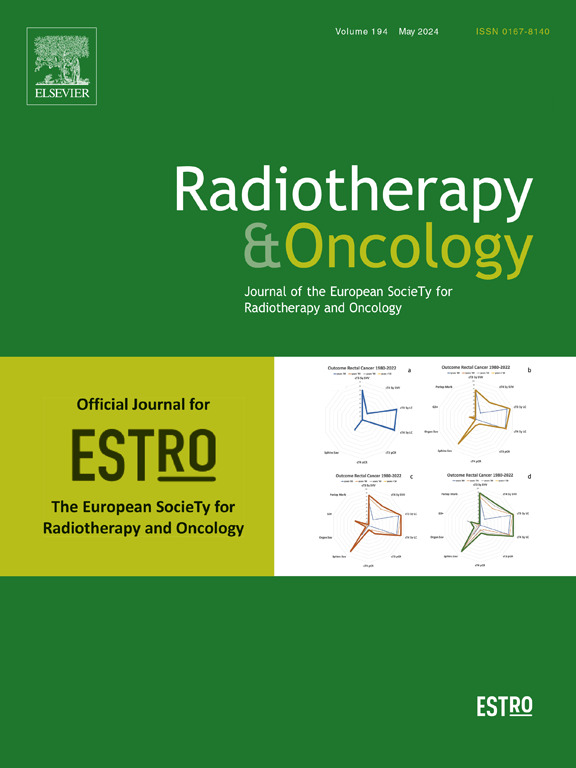Externally validated digital decision support tool for time-to-osteoradionecrosis risk-stratification using right-censored multi-institutional observational cohorts
IF 4.9
1区 医学
Q1 ONCOLOGY
引用次数: 0
Abstract
Background
Existing studies on osteoradionecrosis of the jaw (ORNJ) have primarily used cross-sectional data, assessing risk factors at a single time point. Determining the time-to-event profile of ORNJ has important implications to monitor oral health in head and neck cancer (HNC) long-term survivors.
Methods
Data were retrospectively obtained for a clinical observational cohort of 1129 patients (198 ORNJ cases) with HNC treated with radiotherapy (RT) at The University of Texas MD Anderson Cancer Center. A Weibull Accelerated Failure Time model was trained on previously identified dosimetric, clinical and demographic predictors. External validation was performed using an independent cohort of 265 patients (92 ORNJ cases) treated at Guy’s and St. Thomas’ Hospitals. To facilitate clinical implementation of the model, an online graphical user interface (GUI) was developed, including formal stakeholder usability testing.
Results
Our model identified that gender (males), pre-RT dental extractions and D25% were associated with a 38 %, 27 % and 12 % faster onset of ORNJ, respectively, with adjusted time ratios of 0.62 (p = 0.11), 0.73 (p = 0.13) and 0.88 (p < 0.005). The model demonstrated strong internal calibration (integrated Brier score of 0.133, D-calibration p-value 0.998) and optimal discrimination at 72 months (Harrell’s C-index of 0.72).
Conclusion
This study is the first to demonstrate a direct relationship between radiation dose and the time to ORNJ onset, providing a novel characterization of the impact of delivered dose and patient-related factors not only on the probability of a late effect (ORNJ), but the conditional risk during survivorship.
外部验证的数字决策支持工具,用于使用右审查的多机构观察队列进行骨放射性坏死风险分层
背景:关于颌骨放射性骨坏死(ORNJ)的现有研究主要使用横断面数据,在单个时间点评估危险因素。确定ORNJ的事件时间分布对监测头颈癌(HNC)长期幸存者的口腔健康具有重要意义。方法回顾性分析在德克萨斯大学MD安德森癌症中心接受放疗的HNC患者1129例(其中ORNJ病例198例)的临床观察队列。Weibull加速失效时间模型在先前确定的剂量学、临床和人口统计学预测指标上进行训练。外部验证采用在盖伊医院和圣托马斯医院接受治疗的265例患者(92例ORNJ病例)的独立队列进行。为了促进模型的临床实施,开发了一个在线图形用户界面(GUI),包括正式的利益相关者可用性测试。结果我们的模型发现,性别(男性)、术前拔牙和D25%分别与ORNJ发病速度加快38%、27%和12%相关,调整后的时间比分别为0.62 (p = 0.11)、0.73 (p = 0.13)和0.88 (p <;0.005)。该模型具有较强的内部定标性(综合Brier评分为0.133,d -定标p值为0.998),在72个月时具有最佳判别性(Harrell’s C-index为0.72)。本研究首次证实了放疗剂量与ORNJ发病时间之间的直接关系,提供了放疗剂量和患者相关因素不仅影响晚期效应(ORNJ)概率的新特征,而且还影响了生存期间的条件风险。
本文章由计算机程序翻译,如有差异,请以英文原文为准。
求助全文
约1分钟内获得全文
求助全文
来源期刊

Radiotherapy and Oncology
医学-核医学
CiteScore
10.30
自引率
10.50%
发文量
2445
审稿时长
45 days
期刊介绍:
Radiotherapy and Oncology publishes papers describing original research as well as review articles. It covers areas of interest relating to radiation oncology. This includes: clinical radiotherapy, combined modality treatment, translational studies, epidemiological outcomes, imaging, dosimetry, and radiation therapy planning, experimental work in radiobiology, chemobiology, hyperthermia and tumour biology, as well as data science in radiation oncology and physics aspects relevant to oncology.Papers on more general aspects of interest to the radiation oncologist including chemotherapy, surgery and immunology are also published.
 求助内容:
求助内容: 应助结果提醒方式:
应助结果提醒方式:


